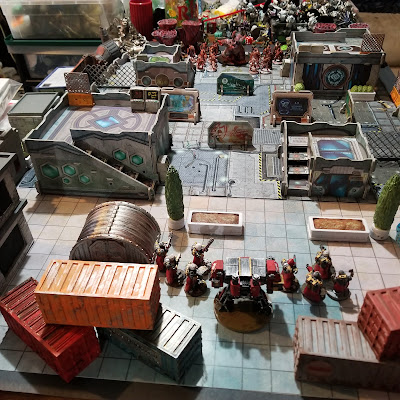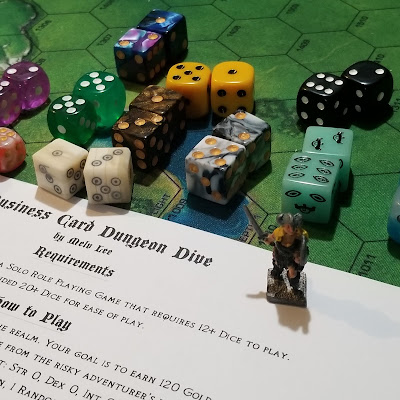My Thoughts on Paper Terrain
I think this is my favorite table spread yet.
So here I am, preparing for a Warhammer 40K themed battle using miniatures from everywhere but Warhammer 40k, and using a modified ruleset from a post-apocalyptic solo game, and I'm finally getting some first-hand experience with paper (or cardstock) terrain. Long story short, there are pros and cons, but man am I glad I took the leap of faith to try all these beautiful things out.
I think like most grognard wargamers, I started with terrain that was all trash or plaster casts. When I was a kid, it was all I could get, and the hard plastic sprue-based ruins that came with the 40k Third Edition box set were about as high-tech as things got. The cost to cover a table was prohibitive for me all the way through high school, (especially since I wasn't that great at trash-bashing,) but I did manage to collect a few pieces of plastic, trash and plaster terrain that I still have (and use) today.
After about a fifteen year break from wargaming, I finally got back into it when I got into 3D printing. Even with a janky, stock Ender 3 printer, I was able to generate more terrain (and miniatures) than I can probably ever hope to paint, but therein lies the problem. Painting. Now that I can acually afford to spend any money at all terrain, I don't have the time to paint it!
So over Yule, (while I was away from my paints and while my printer was broken,) I decided to try something new. I did a bit of research and sunk some cash into Core Space (as much for the minis as for the cardboard terrain) and into a Salvora pack of Infinity Terrain. My thought process was simple: try it out, see what I like, what I don't, and learn from the process.
So here's the results of my research thus far:
Trash Bash Terrain is wonderful. It's free, but unless you're amazing, it can also look cheesy and hard to disguise as anything but former garbage. What does amazing look like? Well, it looks like this, so save your boxes and bottles, wash well, greeble everything up, and you can create something really cool for an unbeatable price point.
Plaster Terrain looks great if you can find it for a good price and/or cast your own. Labor intensive, definitely a hobby in its own right, and I would argue, probably inferior (these days) to the ease of just throwing something together in TinkerCAD and 3D printing it.
3D Printed Terrain is versatile, easy to make, easy to paint and the sky is really the limit in terms of what you can make. Absolutely my favorite. The only downside is waiting literally hours for something like a crate to print, but I'm sure faster, more precise 3D printers will fix this in time. I'm literally using the lowest end printer on the highest end level of detail, so even 28mm miniatures take 2-5 hours to print (depending on the complexity of the miniature.)
Loke Battle Mat Books are a simple way to get decent 2D maps and themes down on a table, but I wouldn't rely on them as a mainstay. Don't get me wrong, they're very well put together, they look good, and if you pop the binding off a book, you'll end up with a bunch of neat maps you can use to fill in the gaps and borders of your table with, or to create little areas for great action shots. I've used them extensively thus far, and you can actually see a couple of those pages at the bottom of the photo above, tucked under each other and under the edge of the Battle Systems neoprene map as a way to expand the play area another foot or so.
Battle Systems Card Terrain has a lot going for it. I love the versatility of it. There are a couple dozen different themed kits, so if you like it, I could easily see someone spending literally $1000+ on this kind of terrain. The kits are big, fill a 2x2 table with multiple levels and cost about $100 each, which is kind of prohibitive for most casual hobbists (like me) but it does fill a table completely, so there's that. I absolutely adore the Battle Systems neoprene mats-- they're high quality (not pixelated) and they're built like giant mousepads, so they're decently heavy and decently flexible. I wish they came in tubes (instead of folded and creased) but the folds come out easy enough over time if you let them breathe. The card terrain is alright-- it's not my favorite, and not really good enough for me to buy any more kits beyond the one that came with Core Space. Despite what people say, I've found that the terrain itself is pretty flimsy and easy to bend, and I've seen some pictures online of some pretty gnarly kits where people have absolutely used and abused the card terrain until everything is warped. Yeah, if you want to fill a table quick, they've got enough themed packs that you could just about do anything you please with one or more of them, but honestly, I prefer solid terrain, like 3D printed bits or Corvus Belli scenery for Infinity. Thin cardboard and warped cardstock throws suspension of disbelief out the window for me.
Infinity Terrain from Corvus Belli is honestly amazing. I'm speaking specifically about the newer kits, like Salvora, Hlokk and Kaldstrom. The older kits are too flimsy for my tastes, but the price point is amazing for those (like $14 for a whole compound), so I guess that makes up for it if you're ok with papercraft terrain. The newer kits are made from thick, solid cardstock that snaps together without bending or breaking in weird ways like the Battle Systems terrain I have does. The buildings are beautiful, simple, and you get a lot of bang for your buck. For about forty bucks, you get four buildings (that are reversable), a host of cyberpunky advertisement walls, consoles and barricades, and you get a map. Now, the maps are pretty, but the neoprene ones from Battle Systems are far superior to them. Honestly, I was so impressed with the Salvora kit I bought that I put the whole thing together the night I got it (took about an hour) and then immediately went online and bought two more.
What I'm doing from now on is basically combining some great assets to make something truly awesome for my gaming experience (and your viewing pleasure, if you enjoy my batt-reps.) I think from now on, I'm going to pick up probably everything new that Corvus Belli does in this card stock style, and I'm probably going to pick up a couple more neoprene maps from Battle Systems, but I can't see myself doing any more Battle Systems cardboard. I'm happy with what I have, but if I'm going to collect something, it has to be durable enough to last me into the forseeable future. I'm going to keep printing my own terrain, but there's just nothing quite like Corvus Belli's buildings or Battle Systems mats that I can make (or print) myself. They're both really spectacular.
As a final note, the total cost of all the terrain you see here is about $95. Ok, so if you factor in that I got the mat from the Core Space set (you can get the mat by itself for about $35), the fact that there are two pages from a Loke book and the fact that I had to buy a $200 3D printer to print the elements (the digital .stl files were free, either because they were from Thingiverse, or because I built them myself in CAD) you'd probably have to spend about $450 to build the same spread in exactly the same way I did. However, if you get the mat by itself, skip the Loke book and ask a friend, someone at a maker lab or at a college maker space to print you a few pieces and pick up the Battle Systems mat ala carte on ebay, you can very probably replicate this whole spread for less than a hundred bucks. How does it play? Well, check the batt-rep I did with Sisters of Battle against the Hordes of Chaos and see for yourself!






Comments
Post a Comment